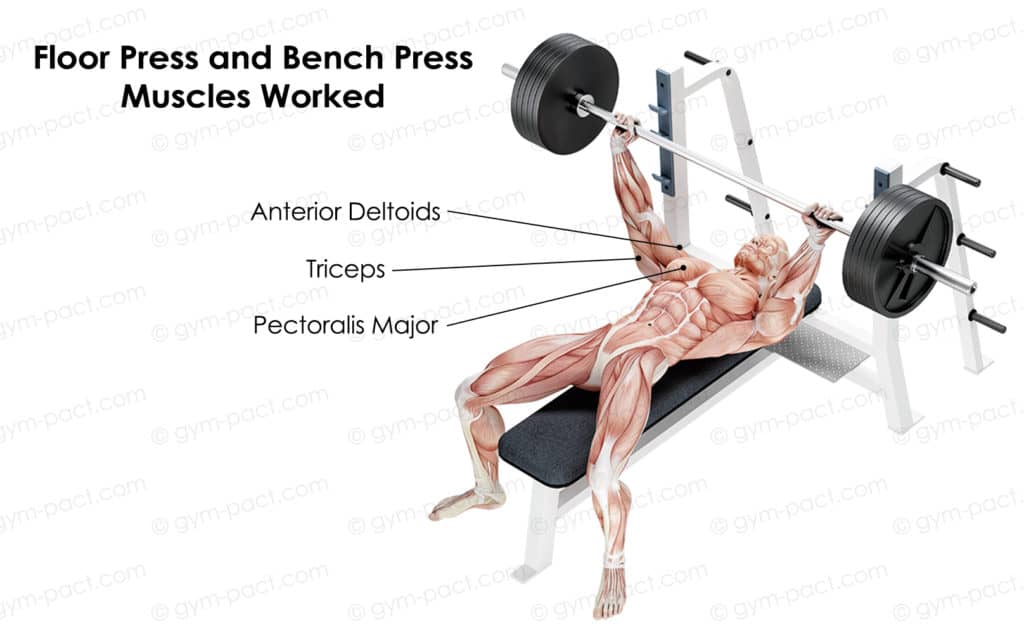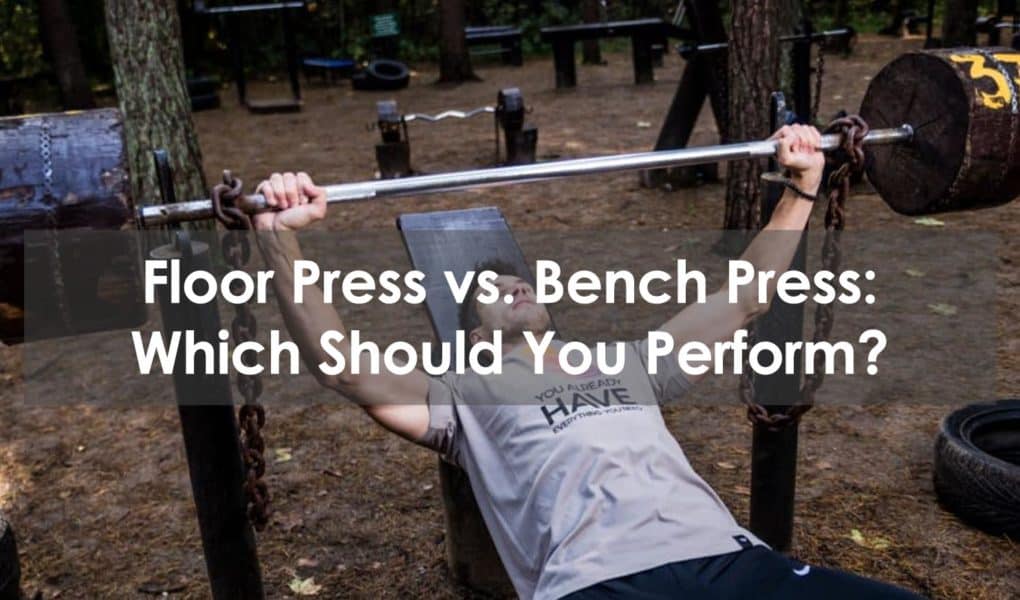The bench press is considered by many to be the “King of Pressing”, and rightfully so as it is used as the basic measurement for pushing strength in the athletic and clinical world. It’s also the most common exercise being performed in the gym.
However, there’s a new exercise that is finding its way into the gym, the floor press. Actually, it’s not that new. The floor press actually was the original exercise that was performed before benches were used. It has still remained a staple in the powerlifting and strong community for years but has just recently become much more popular in the general fitness world. This new exercise has caught many trainees’ eyes and has left them wondering if they should be utilizing it.
Let’s go through these two very similar movements to find out exactly what makes them different. Before we can analyze these movements, we first need to look at how they are performed to identify the differences.
How To Perform The Bench Press
To perform the bench press, you will need:
- A bench for bench pressing or
- A rack and a flat bench
- A barbell
- Weight plates
Now you’re ready to go:
- Set up your barbell and lay down on the bench
- Align your body so that your eyes are directly beneath the bar
- Grab the bar so that your forearms will be vertical at the bottom of the lift. Use the rings for measurement
- Retract your scapula and drive your shoulder blades into the bench using leg drive
- Unrack the bar and bring it over your nipples
- Bring the bar down by bringing your elbows down
- KEEP YOUR ELBOWS AT A 45-DEGREE ANGLE. Do not let them flare
- Bring the bar all the way until it hits your chest (Note: Some lifters aren’t able to due to their biomechanics. In this case, just make sure that your elbows go behind your back
- Use leg drive to push your back into the bench and push the bar up
How To Perform The Floor Press
To perform the floor press, you will need:
- A rack with a low setting for j-hooks
- A barbell
- Weight plates
Now you’re ready to go:
- Set up a rack so that a bar can be placed at a height similar to a bench. Ideally, you can get the bar unracked with about half an inch of elbow flexion. You will need to use whatever height you have though
- Lay on the floor and situate your body so that your eyes are under the bar, similar to the bench press
- Have your legs extended out front
- Grab the bar in the same location as a bench press
- Unrack the bar and bring it over your nipples
- Bring the bar in the same manner as the bench press
- Again, use a 45-degree angle. Do not flare your elbows
- Come down so that your upper arm lays flush on the ground.
- Pause for a second and then drive the bar up
Similarities Between The Bench Press And Floor Press
At first glance, these two exercises look extremely similar. This would be because they do have very much in common. Here are the main similarities between the bench press and floor press.
1. The Muscles Used

The first significant similarity between these two movements is the primary muscles that are trained. Both movements are going to train the:
- Pectorals
- Triceps
- Anterior Deltoids
These three muscles are the main movers of this movement and both will strengthen them
2. They Are Both Horizontal Pressing Movements
There are 6 different planes of movement that every training plan should include weekly. One of those is horizontal pressing. As both of these are horizontal pressing movements, either of them would satisfy this requirement. You can think of them as being in the same “family” of movements.
3. The Form Used
These two movements fundamentally use the same form while performing the movements. This means that the cues for both are similar such as keeping your elbows from flaring as well as the path of the bar.
4. The Equipment That Is Needed
Both of these movements will require a barbell and plates. At the same time, both can also be performed by using dumbbells instead.
Differences Between The Bench Press And Floor Press
So we have the similarities but obviously, there are differences. In fact, there are quite a few. The differences between the two will actually be the main factors to consider on whether or not you should implement them into your program or not.
1. The Set-Up And Equipment Needed
The set-up for these is vastly different and also requires different equipment. The bench press is performed while laying on a bench (obviously) while the floor press is performed laying on the (can you guess?)……the floor!
This means that to perform the bench press, you will need either a specific bench for bench pressing or a rack and a flat bench.
As the floor press is performed on the floor, you must have access to a rack with low slots for J-hooks to allow you to set up a bar low enough. You can also perform them using boxes, but you will definitely need a spotter.
2. Range Of Motion
The main difference between these two movements is the range of motion. The bench press allows the elbows to go past parallel until the bar hits your chest while the floor press only allows you to do down until the back of your upper arm becomes flush with the floor. This can result in a difference of 2-3 inches for most trainees.
3. The Muscles Used
Not ALL of the muscles used are the same. When performing the bench press correctly, you will engage your core extensively and even some leg drive (this is why you’ll see some heavy lifters shake their legs after a lift). However, when you are laying on the floor during the floor press, your legs are entirely taken out of the equation and have less activation in the core.
Further, the floor press puts significantly more tension on the tricep muscle as its pressing power is the main focus of this lift (more below)
4. Level Of Difficulty
Because you are unable to use your legs, the floor press is a significantly more difficult movement to perform. This doesn’t mean it’s difficult to perform; it means that you will not be able to lift as much weight.
5. The Purpose Of The Lift
Both lifts can be used to develop strength or hypertrophy. However, the floor press is generally seen more often in the powerlifting community to develop the triceps’ strength to get past sticking points and improve lockout. It’s used as an assistant lift rather than the main movement. You will often see athletes who only perform overhead pressing (such as strongmen and Olympic lifters) perform the floor press to aid in their lockout. Heavier weights with few reps are usually used for this movement to increase strength.
In terms of hypertrophy, because the bench press has a larger ROM, it will most often be a better choice for those wanting hypertrophy, especially in the chest.
*However, keep in mind that neither of these exercises is the best to build the pectoral muscles. This is a common misconception.
6. Who The Lift Is Appropriate For
Both movements can be used by trainees of all levels. That being said, the floor press is usually used by more intermediate and advanced lifters who are explicitly trying to build their pressing strength.
The one thing to keep in mind is that pressing with a full ROM is essential to maintain the mobility and strength of a joint. This is why beginners may want to put more time into training the bench press. Also, when you first start training, you do not necessarily need specialty movements (the floor press) to increase your strength. This makes the bench press a better choice for most trainees as you will build your strength, improve the mobility and strength of your shoulder joint, and train with more ROM for your pectoral muscles.
Benefits of the Bench Press
The bench press is one of the foundational movements for a reason. It works. The bench press is a proper full-body exercise that can improve the pushing strength of any individual.
As mentioned, the bench press targets the pectoral muscles to a greater extent than the floor press simply because of the press’s longer range of motion. This increases the stretch of the muscle and the loading place upon the chest. This extra ROM means you are going to gain more benefit for hypertrophy AND strength of the pectorals.
The second benefit is that you are going to be able to use a much heavier load than the floor press. This is because of three reasons:
- You have more mechanical advantage
- You are more stable and able to get more leg drive
- You are able to use the stretch-shortening cycle to produce more force
Benefits of the Floor Press
The floor press has many benefits; some are physiological while some are more practical. Its main benefit comes from supplying more activation in the triceps than the bench press. This means more strength gains. When performed correctly, the triceps should pause for a second on the floor. This will either mitigate or completely get rid of the stretch reflex. That means your triceps are going to have to work in overdrive to get the bar up as it will receive no assistance from stored energy in the tendons. Further, as your legs are laid straight out, your upper body is left by itself to generate the power needed to move the bar. If you’re looking to develop raw power, especially in your triceps, the floor press is for you.
The second benefit of the floor press is that it is a great exercise to perform if you suffer from shoulder pain. Due to the lack of ROM, the floor press is a great movement to perform as it will relieve a lot of the stress on the elbow while still allowing you to get in your horizontal pressing. Further, it can act as a tactile cue for your elbow placement because you come down to the floor.
The third benefit is that you can perform the floor press for home workouts! You will need to perform a slight variation using dumbbells, but this is impossible to do with the bench press (assuming you don’t have a home gym).
Bench Press vs Floor Press – Which Exercise Should You Do?
Instead of choosing which one to do, you can easily just do both in the same program. The best way to program this is if you are hitting the same muscle groups twice a week. This has been shown to be the optimal level of frequency to generate a quantity of quality. What this means is that you should do some horizontal pressing twice a week.
It would be best to use your days using moderate weight (6-8 reps) with the bench press and your heavier days using floor pressing (3-5 reps). For either one, make sure you have a spotter.
- Session 1 Bench Press 4×8
- Session 2 Floor Press 5×5
A common practice is to perform push-ups after your floor pressing so that you can get in more volume with a larger ROM
Frequently Asked Questions
Can you get the same results doing dumbbell floor press as dumbbell bench press?
The variance in your results will be the same as when using a barbell. The differences between the dumbbell floor press and dumbbell bench press are going to be the same as when using the barbell. This means that the differences in benefits and use will be the same.
Should You Use The Bench Press Or Floor Press?
Now that you see all of each lift’s benefits and practicality, you can choose which one would be best for you. If you’re looking for general fitness, there is really no need to use the floor press unless you have shoulder problems or just want to try something different to keep things interesting.
What Is A Good Alternative To The Floor Press?
A great alternative to the floor press for training the triceps is to perform the close-grip bench press. As your hands are closer together, you will need to flex the arms farther to get the bar down to the chest. This increases the ROM and the triceps extension needed.







